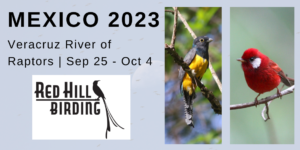Jorge Montejo & Amy McAndrewsPrice: $3450
Based on double occupancy
$350 single supplement*Maximum group size is 10 participants
Visit the trip webpage for full details and itinerary: www.redhillbirding.com/veracruz
To register for the trip, visit www.redhillbirding.com/bookingform
There are few locations in the world that can claim to be a global migration destination, but Veracruz in fall is on that short list. Each autumn, millions of migrating birds use a narrow corridor along the coastal state of Veracruz to migrate south. Raptors are directed to this region by the looming Sierra Madre Oriental to the West and Gulf of Mexico to the east, which leaves a narrow lowland passage for migrant birds to use.
The result is one of the greatest migration spectacles in the world. Nearly the entire global population of Mississippi Kites, Broad-winged Hawks, and Swainson’s Hawks will pass over Veracruz in October, as well over a million Turkey Vultures. Over 2 million raptors are annually counted from hawk watch sites in the region. Mixed in with the boreal migrants are species more typical of the tropics, including Hook-billed Kite, Short-tailed Hawk, and Roadside Hawk.
If the raptors weren’t enough, many other species use this corridor to migrate. Large movements of Anhinga, Wood Stork, and American White Pelican can be expected alongside the raptors while White-winged Doves, Scissor-tailed Flycatchers, and many other land birds put on amazing flights as they move south. It’s not even just the birds! Millions of butterflies and dragonflies also pass through this region on their journey south.
Veracruz is also home to varied habitat including coastal lagoons and marshes, tropical deciduous forests, and high-altitude pine/oak woodlands. While the migration is spectacular, we also spend time in these habitats to search out the beautiful resident species including numerous Mexican endemics like Mexican Sheartail, Bumblebee Hummingbird, Strickland’s Woodpecker, Bluecrowned Motmot, Transvolcanic Jay, Red Warbler, Gray-barred Wren and many others.
In Collaboration with Illinois Ornithological Society

